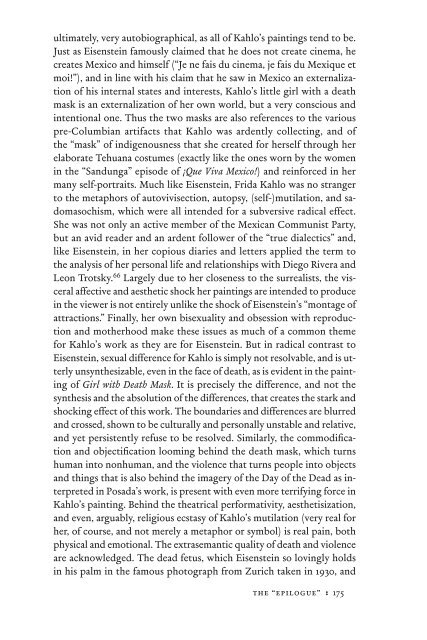In Excess: Sergei Eisentein's Mexico - Cineclub
In Excess: Sergei Eisentein's Mexico - Cineclub
In Excess: Sergei Eisentein's Mexico - Cineclub
Create successful ePaper yourself
Turn your PDF publications into a flip-book with our unique Google optimized e-Paper software.
ultimately, very autobiographical, as all of Kahlo’s paintings tend to be.<br />
Just as Eisenstein famously claimed that he does not create cinema, he<br />
creates <strong>Mexico</strong> and himself (“Je ne fais du cinema, je fais du Mexique et<br />
moi!”), and in line with his claim that he saw in <strong>Mexico</strong> an externalization<br />
of his internal states and interests, Kahlo’s little girl with a death<br />
mask is an externalization of her own world, but a very conscious and<br />
intentional one. Thus the two masks are also references to the various<br />
pre-Columbian artifacts that Kahlo was ardently collecting, and of<br />
the “mask” of indigenousness that she created for herself through her<br />
elaborate Tehuana costumes (exactly like the ones worn by the women<br />
in the “Sandunga” episode of ¡Que Viva <strong>Mexico</strong>!) and reinforced in her<br />
many self-portraits. Much like Eisenstein, Frida Kahlo was no stranger<br />
to the metaphors of autovivisection, autopsy, (self-)mutilation, and sadomasochism,<br />
which were all intended for a subversive radical effect.<br />
She was not only an active member of the Mexican Communist Party,<br />
but an avid reader and an ardent follower of the “true dialectics” and,<br />
like Eisenstein, in her copious diaries and letters applied the term to<br />
the analysis of her personal life and relationships with Diego Rivera and<br />
Leon Trotsky. 66 Largely due to her closeness to the surrealists, the visceral<br />
affective and aesthetic shock her paintings are intended to produce<br />
in the viewer is not entirely unlike the shock of Eisenstein’s “montage of<br />
attractions.” Finally, her own bisexuality and obsession with reproduction<br />
and motherhood make these issues as much of a common theme<br />
for Kahlo’s work as they are for Eisenstein. But in radical contrast to<br />
Eisenstein, sexual difference for Kahlo is simply not resolvable, and is utterly<br />
unsynthesizable, even in the face of death, as is evident in the painting<br />
of Girl with Death Mask. It is precisely the difference, and not the<br />
synthesis and the absolution of the differences, that creates the stark and<br />
shocking effect of this work. The boundaries and differences are blurred<br />
and crossed, shown to be culturally and personally unstable and relative,<br />
and yet persistently refuse to be resolved. Similarly, the commodifi cation<br />
and objectifi cation looming behind the death mask, which turns<br />
human into nonhuman, and the violence that turns people into objects<br />
and things that is also behind the imagery of the Day of the Dead as interpreted<br />
in Posada’s work, is present with even more terrifying force in<br />
Kahlo’s painting. Behind the theatrical performativity, aesthetisization,<br />
and even, arguably, religious ecstasy of Kahlo’s mutilation (very real for<br />
her, of course, and not merely a metaphor or symbol) is real pain, both<br />
physical and emotional. The extrasemantic quality of death and violence<br />
are acknowledged. The dead fetus, which Eisenstein so lovingly holds<br />
in his palm in the famous photograph from Zurich taken in 1930, and<br />
the “epilogue” : 175


